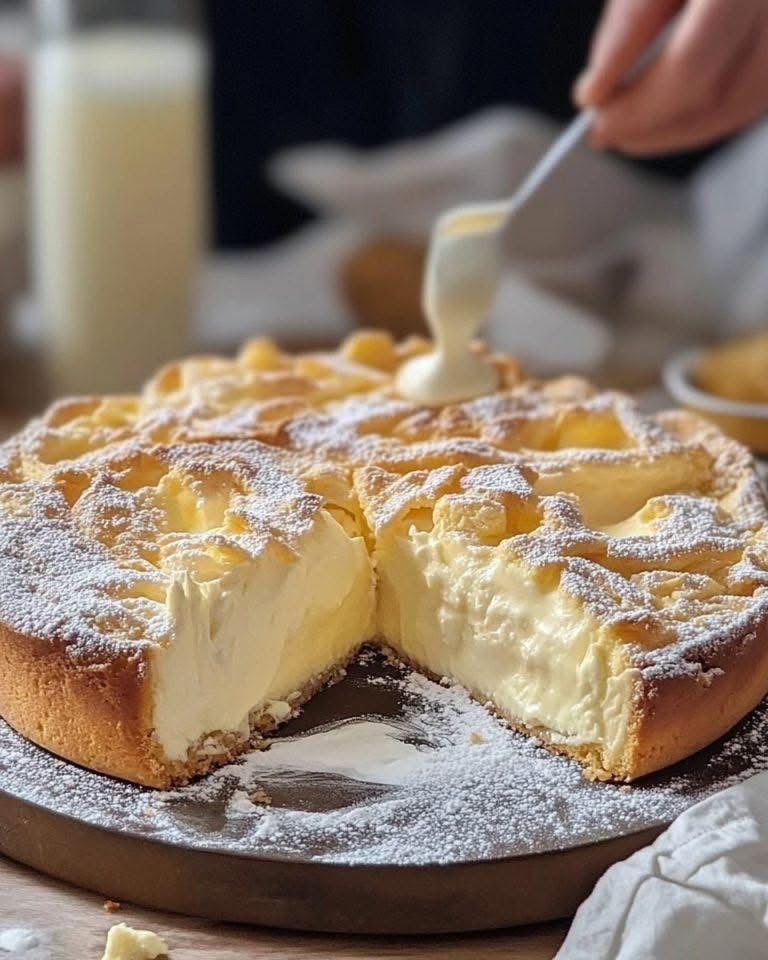
🇩🇪 German Cream Cake (Käsesahnetorte)
A soft, creamy, dreamy no-bake cheesecake with a hint of citrus and a fluffy sponge base.
🥮 Introduction
German Cream Cake, known as Käsesahnetorte, is a no-bake cheesecake layered between fluffy sponge and rich whipped cream mixed with quark or cream cheese. Light yet indulgent, it’s a European classic often served in cafés, family gatherings, and celebrations. The airy texture and tangy-sweet flavor balance make it irresistible.
🧺 Ingredients
For the Sponge Cake Base:
- 4 eggs
- 120g (1/2 cup) sugar
- 1 tsp vanilla extract
- 1 pinch of salt
- 120g (1 cup) all-purpose flour
- 1 tsp baking powder
For the Cream Filling:
- 500g (2 cups) quark or substitute with cream cheese + Greek yogurt
- 300ml (1 1/4 cups) heavy cream
- 150g (3/4 cup) sugar
- Zest and juice of 1 lemon
- 8 sheets of gelatin or 2 tbsp powdered gelatin
- 1 tsp vanilla extract
- Optional: 2 tbsp of orange liqueur or milk
For Dusting:
- Powdered sugar
🧑🍳 Instructions
🌟 Step 1: Prepare the Sponge Cake Base
- Preheat the oven to 180°C (350°F). Line a springform pan (9-inch) with parchment.
- Beat the eggs, sugar, salt, and vanilla until light and fluffy (about 5-8 minutes).
- Gently fold in sifted flour and baking powder.
- Pour into the pan and bake for 20–25 minutes until golden.
- Let it cool completely. Then slice into 2 even layers if needed.
🌟 Step 2: Prepare the Cream Filling
- Soak gelatin sheets in cold water for 10 mins (or bloom powdered gelatin in 5 tbsp cold water).
- Beat quark (or cream cheese + yogurt), sugar, lemon juice, lemon zest, and vanilla until smooth.
- Heat gelatin gently until dissolved and mix with 2 tablespoons of the quark mix to temper. Stir into the rest of the filling.
- Whip the cream until stiff peaks form. Fold gently into the mixture.
🌟 Step 3: Assembly
- Place one layer of sponge at the base of a springform pan.
- Pour cream filling over and smooth the top.
- Optionally, place the second sponge layer on top or leave it open.
- Chill for at least 4 hours, ideally overnight.
🌟 Step 4: Finish and Serve
- Remove from pan carefully.
- Dust generously with powdered sugar.
- Serve cold. Enjoy!
🧬 Formation Process Summary
- Base: Light sponge cake.
- Middle: Creamy, airy lemon-quark mousse.
- Top: Optionally topped with another sponge or left open with powdered sugar.
📜 History
Käsesahnetorte dates back to post-war Germany where creative home bakers, constrained by ingredients, began using quark, a soft cheese, to make lighter alternatives to baked cheesecakes. It quickly became a staple of Konditoreien (German pastry shops). Unlike American cheesecakes, it’s uncooked and known for its fresh, airy, almost mousse-like consistency.
💪 Health Benefits
Though indulgent, this cake offers:
- Protein from quark/cream cheese
- Calcium for bone health
- Lemon juice and zest offer Vitamin C
- Low gluten due to minimal flour
Moderation is key, but its lightness makes it a gentler dessert choice.
🧠 Nutritional Info (Approximate per slice – 1/10 of cake):
- Calories: 290 kcal
- Protein: 7g
- Fat: 20g
- Carbs: 22g
- Sugar: 17g
- Calcium: 120mg
💕 Lovers of This Cake
- Classic European dessert lovers
- Cheesecake fans wanting a lighter twist
- Lemon and citrus lovers
- Those avoiding heavy, baked desserts
- Couples on cozy afternoons with coffee ☕
- Kids who enjoy creamy, fluffy textures
📌 Methods Recap
- Baking (for the sponge base)
- Folding (for delicate cream mixture)
- Chilling (to set the cake)
- Dusting (for final beauty touch)
🏁 Conclusion
The German Cream Cake is more than a dessert—it’s a soft cloud of sweetness with a delicate balance of texture and taste. With roots in comfort and innovation, it unites the tang of quark with the fluffiness of cream, making every slice a celebration.
❤️ Final Note for Cake Lovers
If you adore desserts that are rich yet refreshing, creamy yet light, this cake is your soulmate. Ideal for birthdays, spring brunches, afternoon tea, or just because. A lovingly made Käsesahnetorte will win the hearts of anyone lucky enough to taste it.